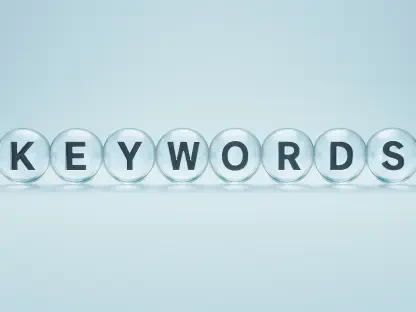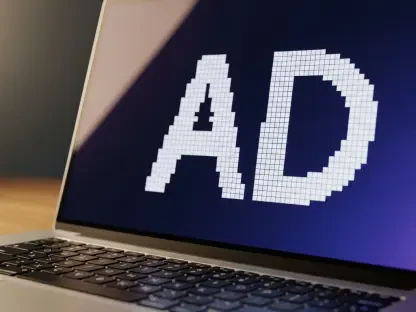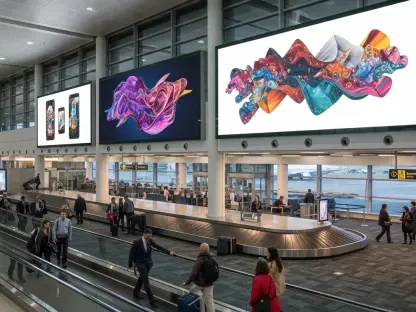In the dynamic realm of digital advertising, where billions of dollars are invested each quarter to capture consumer attention, a staggering $770 million in programmatic ad spend has slipped through the cracks in Q2 of this year. This colossal loss, directed toward Made for Advertising (MFA) properties—platforms engineered to maximize ad revenue with minimal valuable content or user engagement—raises urgent questions about the integrity of the ad ecosystem. What drives such a massive drain on budgets, and how can the industry respond to this hidden threat? This market analysis dives deep into the trends, data, and implications of MFA properties, offering a lens into the challenges and opportunities shaping programmatic advertising today.
Exposing the Scale of Loss: A Market Overview of MFA Impact
The digital advertising market, a powerhouse of innovation and scale, faces a persistent challenge as MFA properties siphon off significant portions of ad budgets. In Q2 of this year, an estimated $770 million in global programmatic ad spend was funneled into these low-value environments, representing a critical inefficiency in an industry reliant on precision and return on investment. This figure highlights not just a financial loss but also a breach of trust, as advertisers expect their dollars to reach engaged, authentic audiences rather than ad-stuffed platforms with little substance.
Breaking down this loss reveals stark disparities across platforms. Websites dominate the MFA landscape, absorbing $716 million, which equates to 10% of total global open programmatic web ad spend—a notable rise from earlier quarters. Meanwhile, Connected TV (CTV) apps and mobile apps account for $25 million and $29 million, respectively, signaling emerging vulnerabilities in newer advertising channels. These numbers underscore a broader market trend: as digital ad spend grows, so does the sophistication of schemes designed to exploit programmatic systems, necessitating a closer examination of traffic quality and platform legitimacy.
The regional lens adds another layer of complexity to this market issue. Latin America (LATAM) stands out with a 21% rate of programmatic ad spend on likely MFA websites, far exceeding other regions. This disparity suggests unique market dynamics, possibly tied to less stringent oversight or a higher concentration of questionable publishers, which advertisers must navigate when allocating budgets globally. Understanding these geographic nuances is essential for crafting targeted strategies to mitigate MFA-related losses.
Platform-Specific Challenges: Dissecting Trends Across Web, CTV, and Mobile
Websites as the Primary Culprit: A $716M Market Drain
MFA websites remain the most significant drain on ad budgets, commanding $716 million in lost spend in Q2. This segment’s share of global programmatic web ad spend has climbed to 10%, reflecting a troubling trend of increasing prevalence. Many of these sites operate by hosting auto-generated or recycled content, prioritizing ad density over user value, which not only wastes budgets but also risks brand safety by associating advertisers with substandard environments.
The market challenge here lies in detection and prevention. Programmatic ecosystems, built for speed and scale, often struggle to differentiate between legitimate publishers and MFA properties that mimic credible platforms. This opacity fuels the ongoing loss, pushing the industry to adopt more robust verification tools and real-time monitoring to stem the tide of misallocated spend in the web advertising space.
CTV Apps on the Rise: A $25M Emerging Threat
As streaming platforms gain traction among consumers, CTV apps have become a burgeoning channel for advertisers—and unfortunately, for MFA operators as well. In Q2, $25 million in ad spend was directed to MFA-flagged CTV apps, with their share doubling over the quarter to 0.6%. This rapid growth signals a shift in fraud tactics toward newer, high-engagement mediums where oversight mechanisms are still evolving.
The CTV market’s unique structure, with closed ecosystems and diverse app store policies, complicates efforts to identify fraudulent properties. Advertisers are drawn to the potential of reaching captive audiences through streaming, but without stricter vetting and transparency, the risk of wasted spend looms large. This trend points to an urgent need for market players to develop specialized tools tailored to CTV environments.
Mobile Apps and Transparency Woes: The $29M Hidden Cost
Mobile apps, while a smaller slice of the MFA loss at $29 million, present a distinct market challenge due to transparency gaps. A striking 89% of this spend is tied to apps with private or undisclosed domains, obscuring the origins of traffic and making fraud detection difficult. This lack of visibility enables MFA properties to inflate engagement metrics, deceiving advertisers into funding ineffective impressions.
Addressing this segment of the market requires tackling the inherent opacity of mobile ecosystems. Unlike websites, mobile apps often operate behind veiled data points, limiting the ability to scrutinize traffic sources. Pushing for greater domain disclosure and leveraging third-party analytics could help illuminate these blind spots, protecting ad budgets from unseen erosion in the mobile space.
Future Projections: Navigating the Evolving MFA Landscape
Looking ahead, the programmatic advertising market stands at a crossroads as MFA properties adapt to emerging technologies and channels. The uptick in MFA-flagged CTV apps suggests that fraud will increasingly target high-growth areas, potentially escalating losses if unchecked. Over the next two years, from this year to 2027, the share of ad spend lost to MFA could rise further unless proactive measures are implemented across platforms.
Technological advancements offer a glimmer of hope for the market. Innovations in artificial intelligence and machine learning are poised to enhance fraud detection by analyzing vast datasets for suspicious patterns in real time. However, fraudsters are equally agile, likely to exploit gaps in newer ad formats like CTV or immersive experiences, challenging the industry to stay ahead through continuous adaptation and investment in cutting-edge solutions.
Regulatory and economic shifts could also reshape this market dynamic. Growing advertiser demand for transparency, coupled with potential policy changes around ad verification, may force platforms to tighten controls. Without collaborative efforts among stakeholders—advertisers, ad tech providers, and publishers—the market risks seeing MFA losses balloon in future quarters, underscoring the importance of unified standards and preemptive strategies to safeguard budgets.
Reflecting on the MFA Crisis: Strategic Steps Forward
Looking back on Q2 of this year, the $770 million loss to MFA properties served as a stark reminder of the vulnerabilities embedded in the programmatic advertising market. The dominance of websites in this loss, alongside emerging risks in CTV and mobile apps, painted a picture of an industry grappling with both entrenched and evolving threats. Regional disparities, particularly in LATAM, further highlighted the uneven exposure to MFA challenges across global markets.
Moving forward, actionable steps emerged as critical for mitigating such losses. Advertisers were encouraged to invest in third-party verification tools to flag and block MFA traffic, while partnering with demand-side platforms that prioritize quality over volume offered a buffer against fraud. Advocating for industry standards, such as enhanced domain transparency for mobile apps and rigorous vetting for CTV platforms, became a priority to close exploitable gaps.
Beyond immediate tactics, a long-term vision took shape, focusing on fostering collaboration across the ad ecosystem. Building frameworks for blockchain-based verification or standardized quality metrics stood out as potential game-changers to ensure ad spend reached genuine, high-value environments. This period of reflection cemented the notion that combating MFA properties demanded not just reaction, but sustained innovation and commitment to transparency for a resilient advertising future.









